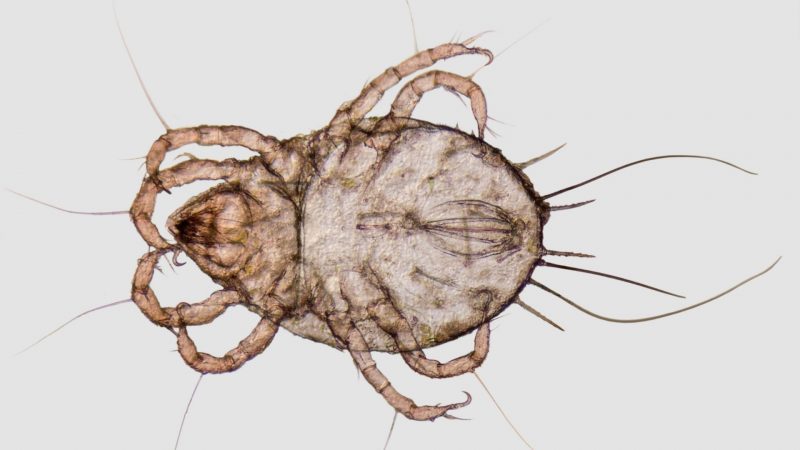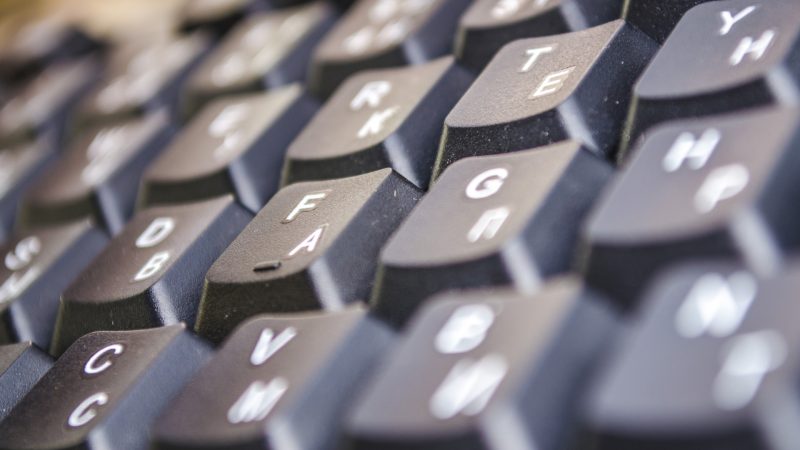Computer mites can slowly degrade your computer, and they can also impact your health. Getting rid of them sooner rather than later can help extend the life of your device while also keeping you safe from painful bites or complicated respiratory problems.
How to get rid of computer mites? To get rid of computer mites, you’ll first need to identify the type of mite you’re dealing with. Dust mites are best treated with pressurized air and consistent cleaning. On the other hand, you can get rid of mold mites by cleaning your computer and avoiding humid environments.
If you think you may have insects on your laptop or desktop computer, you’ll want to identify them right away. After all, tiny bugs in electronics can turn into massive problems if not treated right away. So, read on to learn how to get rid of computer mites quickly and effectively!
What Are Computer Mites?

Computer mites are tiny creatures that are typically invisible to the naked eye. However, they can live inside or on your computer, causing significant health problems and slowly ruining your device.
Still, computer mites aren’t a single species. You can have several different types of mites living in your hardware, and two of the most common of these computer-loving pests are:
- Mold mites
- Dust mites
Insects can also find their way into your laptop or PC, and some are commonly confused with mites. For example, bed bugs are relatively small and tend to stay out of sight during the day. However, they can appear brown or reddish after feeding, just like a trombiculid mite (also called a chigger mite). Some species of tiny ants can also be misidentified as mites.
Choosing the right pest control solution means appropriately identifying the problem. As such, it’s crucial to familiarize yourself with the appearance, behavior, and feeding habits of these various PC-attacking pests.
Related: Can You See Bed Bugs with the Naked Eye?
How to Identify Computer Mites?

Identifying computer mites can be challenging, as there are many types of mites. Still, there are some common signs and symptoms to watch for.
For example, mold mites tend to form a light white or brown dust-like surface on affected electronics. So if you spot stubborn dust on your laptop that doesn’t respond to a dry wipe, you may have dust mites living in your computer.
Seeing tiny red insects crawling across your screen or around your keyboard could be a sign of chigger mites but those bugs could also be ants or bed bugs. Either way, these creatures can infest your computer if it looks like an attractive habitat for them.
Can Mites Get in Electronics?

Mites can get in the most well-sealed electronics. That’s because mites are almost microscopic creatures. They can slide into tiny openings or partitions that are unseen by the naked eye.
Dust mites can get inside electronics by following bits of dead skin. The American Lung Association notes that these mites are common sources of household allergens. Mold mites can also enter and inhabit devices if there’s mold present inside them.
According to researchers at the University of Kentucky College of Agriculture, chigger mites are also attracted to humid areas. If you live in or near a wooded area, you may see these tiny red bugs scuttling around your keyboard or monitor.
How Do Mites Get In Laptop?
The size of mites ranges from about 1/60 of an inch to the micron level. As such, they can see openings that are invisible to the human eye. Though your laptop might seem perfectly sealed, it’s full of doorways for mites.
Not only can mites enter your laptop through seams or gaps between your keyboard keys, but they can also crawl in through your device’s vents. Rather than attempting to block off all of these potential entrances, it’s far better to make your laptop’s interior an inhospitable place for mites.
Related: Ants in Laptop | How to Get Rid of Ants in Your Laptop
Do Computer Mites Bite?
Computer mites bite, but because most of them are so small, their bites do virtually zero damage. However, many of the most common species of computer mites can be harmful to your devices and overall health.
Mold mites – They can contribute to respiratory distress, as they’re often indicative of mold growth. If you spot a mold mite colony growing on your device, your other electronics may also be full of dangerous mold spores.
Dust mites – They tend to be the least harmful, though they can also contribute to breathing problems if allowed to collect. That’s why it’s crucial to clean and vacuum your computer from time to time. Naturally, you’ll want to use a device-safe vacuum to avoid damaging sensitive components.
Bed bugs – They are commonly confused with chigger mites. Bed bugs are maybe the most aggressive biters. These insects tend to appear during the night, but they can be consistently active in dark rooms. Watching for signs of these pests can help you avoid painful bites.
Signs of Bed Bugs in Laptop

Unlike mold or dust mites, bed bugs feed off the blood of mammals. Many people aren’t even aware they’ve been bitten until several hours have passed. That’s because this pest’s saliva contains an anesthetic.
Though these bugs tend to infest upholstered surfaces and bedding (hence their name), they can also inhabit baseboards, carpets, and electronic devices. Sadly, it can be nearly impossible to spot early signs of a laptop bed bug infestation.
Unlike a desktop tower, laptops aren’t designed to be opened up for regular cleaning. Additionally, bed bugs are incredibly small. They’re also known for their nocturnal feeding habits, so you may never see them during the daytime.
That being said, the following are some signs of bed bugs in your laptops:
- Reddish-brown stains on hardware.
- Tiny black or white bits of debris on the keyboard.
- A powerful unpleasant odor coming from your laptop.
Related: Bed Bugs in Electronics: Can Bed Bugs Live in Electronics?
Bed Bug Laptop Treatment Options
Getting rid of bed bugs in your laptop often requires some patience. After all, standard over-the-counter pesticides can be dangerous to apply to your device. Instead, the better option for getting rid of these bloodsuckers might be a combination of quarantine and temperature control.
To rid your laptop of pesky bed bugs, you can do the following:
Step 1: Isolate the PC or laptop. You should place it in a waterproof container or bag that’s airtight. A thick trash bag, plastic shopping bag, or lockable storage container could do the trick.
Step 2: Take your laptop or PC outside to a parking lot away from your house and open it. Use a vacuum or pressurized air can to clean your laptop. Be careful where they spread, you don’t want them on your clothes or to spread on your other things.
Step 3: Put the laptop back inside the vacuum bag with the Nuvan ProStrip. This will make sure that all of them die while not damaging your laptop or the PC.
Click on the following link for more details on how to get rid of bed bugs in electronics.
Do Bug Bombs Affect Electronics?
Bug bombs can affect electronics as some chemicals can be corrosive. Also, the majority of bug bombs are designed to release pesticides into the air. Tiny particles of these chemicals may drift down and settle onto household surfaces, forming a greasy layer.
After setting off a bug bomb inside your home, you’ll likely need to wipe your counters clean and vacuum or shampoo your carpet to get rid of these residual chemicals. If you activate a bug bomb near your laptop or computers, it can coat its components in sticky, potentially corrosive pesticides.
If you have laptop mites or tiny insects in your computer, you’ll want to use non-pesticidal solutions to get rid of them. Fortunately, proper temperature and moisture control is often an effective way to get rid of computer mites.
How to Get Rid of Mold Mites on Computer?
If you see tiny white bugs on your electronics or laptop, you may have various strains of mold growing inside those devices. Not only can this mold cause serious technical problems, but it could also impact your health.
To get rid of mold mites on your computer, you can do the following:
- Place your devices in moisture-absorbing rice or store them near a powerful dehumidifier. According to Iowa State University, these mites only develop where there is moisture or a high humidity.
- Any mold or mite colonies growing along your laptop keyboard, screen, or exterior should be wiped away with an alcohol pad and a clean paper towel. This way, you can begin discouraging growth and mite reproduction.
The sooner you act to remove mold spores, the less likely it is that your laptop will suffer severe damage. You’ll also be able to say goodbye to mold mites for good!
How to Get Rid of Insects Inside Computer Screen?
If you’ve already eradicated your bug problem, and you can see dead bugs behind your screen, you’ll likely need to contact a professional computer technician to help you clean it away.
That’s because most computer screens and monitors aren’t designed for DIY repairs. Working with these electronics can result in cuts, electrocution, and potential contact with poisonous internal elements.
What to Use to Repel Mites From Laptop or Computer?
To repel mites from your laptop or computer, you’ll need to consider what attracts mites in the first place. This will involve keeping your computer clean, keeping your humidity low, and keeping infestations from arriving in your home.
Dust mites – They feed on dead human skin cells. Because you can’t stop your dead skin from shedding, daily or weekly cleaning is the best solution for those mites.
Mold mites – They are attracted to mold growth, so stopping mold from growing inside your device can help put an end to those types of infestations. Installing a dehumidifier next to your desktop tower and immediately drying your laptop after a spill is a great way to avoid mold mites.
Related: Chigger Bite Treatment (Relief), Chigger Control and Prevention Guide
List of Sources
Dust Mites. (2021). American Lung Association.
Mold Mites. Iowa State University.
Townsend, L., Potter, M. (2008). Chiggers. University of Kentucky.
Shindelar, A., Kells, S. (2011). Using Freezing Conditions to Kill Bed Bugs. University of Minnesota.
- How to Get Rid of Cockroaches? | Proven Strategies & Solutions! - June 24, 2023
- Powerful Homemade Wasp and Bee Sprays (with Recipes) - March 4, 2023
- Crazy Ants Invasion | Eradicate & Prevent Unwanted Guests - February 24, 2023

